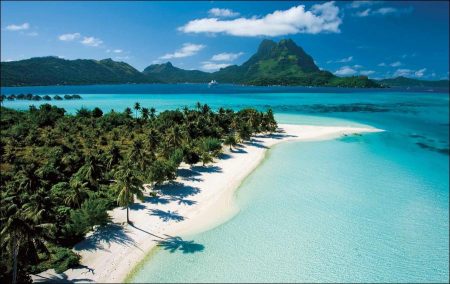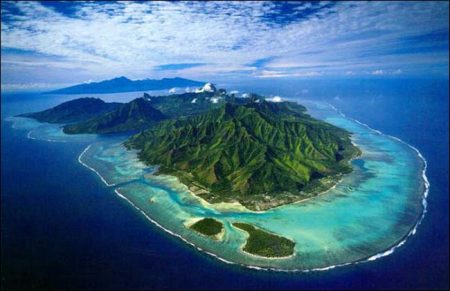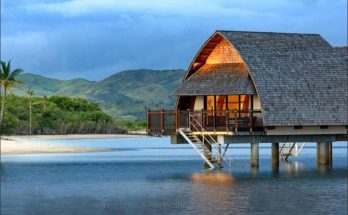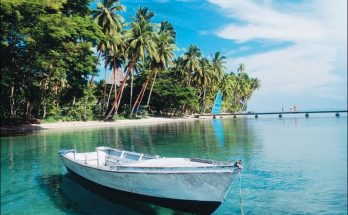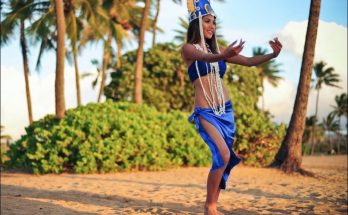To a Polynesian religion was as much a part of his everyday life as were the stones with which he built his house platforms or the wood of his canoe, or as his eating and drinking. Religious thought and physical effort were parts of all activities. Birth, death, and work had a religious as well as a physical meaning. To accomplish an undertaking it was as necessary to perform appropriate religious rites as it was to have the right kinds of tools.
The things in nature were thought to have individual life. Land, sea, stones, stars, and other natural objects grew and changed and moved just as do trees and animals and men. The Maori Rangi, the heavens, was a thinking, living being, having its own peculiar form. In TahitiTaa-roa, the creator, was thought to have human form.
The Polynesian recognized the regularity of nature — day follows night, stars move across the heavens, seeds grow into plants, waves respond to the wind — and explained it by the belief that the forces of nature, each an independent living thing, worked in harmony with each other.
Mana
Every human being, every god and spirit, every animal and plant, every stone, every star, every hill and valley, differed from every other in its class, because each had a different amount and a different kind of mana. The power and dignity of a sacred chief was his mana, part of which he inherited from his godlike ancestors. The mana of the priest was shown by his knowledge of things to come and of how the people should act. He obtained his mana by study and by rites which brought him close to powerful spirits.
The mana of the orator, the poet, and the teacher, the fisherman, the canoe builder, the house builder, and the farmer was shown by his skill. The unjust ruler, the dishonest priest, the unskillful workman were said to have lost their mana through some ignoble action or perhaps never to have had mana. Some weapons and tools had mana. A canoe without mana could not be swift, and fishhooks without mana were not of much use. For the Maori some streams, mountains, and lakes had mana which made them beautiful places and enabled them to protect, comfort, and bring good luck to those who stayed among them.
The Polynesians did not separate what we call natural from what we call supernatural. To them everything in the world -gods, men, animals, heavenly bodies, islands, wind, rain, rocks, mountains, valleys, and sea — are related because they all descended generation after generation from a “Sky Father” and an “Earth Mother.”
Tapu
Polynesian religion recognized things and actions which were holy, sacred, and good, and things and actions which were unholy, common, or bad. To mark the difference and to see that these differences were accepted by the people, the system of tapu (otherwise taboo or tabu — in Hawaiian, kapu) was established. The chief was tapu because he represented the sacred god, and everything connected with worship was tapu. In some islands the chief was so sacred that to come within his shadow might mean death.
Throughout Polynesia places of worship were tapu except for those who were specially set apart to act in the services. Religious services were tapu, and while some of them were being performed all work was forbidden. Fish caught was tapu until some had been offered to the gods who assisted in the successful catch. Some things were marked tapu merely for the personal benefit of the chief or priest. Evil spirits and unclean things were also tapu and must not be touched under pain of disaster and death. In general women were considered inferior to men and were forbidden by tapu to enjoy certain foods and certain pleasures which men might freely enjoy.
The Chief
The central figure in Polynesian worship was the chief who combined the offices of leader and priest. The people thought of him as divinely born and therefore believed him to represent the gods from which he came and the people over whom he ruled. Through him the tribe might approach the gods, and through him the gods spoke to the tribe. Because of his close relations with the gods, this sacred chief was supposed to be able to prevent droughts, famine, failure of crops, and other disasters, and if these disasters came the chief was supposed to be careless or guilty. The chief therefore must be wise and strong and generous. He must take great care of himself, and his people must see that he lived safely and in comfort. From his birth he was treated as sacred. He had special food, special companions, and lived in a special place.
The position of the sacred chief was not the same in all the Polynesian islands. In some he owned all the land and all the people. His person was so sacred that no one could touch his body or his clothes or come within his house without fear of death, and when he went out the people who saw him. must cease work, remove their clothing, and remain bowed down until he had passed. In other islands the chief had much less religious power, and in some islands the chief was merely the leader, religious rites being performed by priests.
Souls lived after death
The Polynesians believed that the souls of men continued to live after the death of the body and had power to aid or injure the families to which they belonged. Departed spirits were thought to be still members of the family or tribe to which they belonged on earth. At some places in Polynesia the spirit of almost every person was represented by a relic which was sacred.
Especially the bones of human beings were considered sacred and protected by a tapu to prevent injury to them. They were concealed in caves, hidden away among rocks or in the dense jungles, or placed within inclosures which no one could enter. The burial places of tens of thousands of bodies are no longer known. The head, which was supposed to be the most sacred part of the body, was especially preserved and guarded.
Places of worship
In all the Polynesian islands are places of worship, some of them protected by an inclosing wall. In them were houses for the priests and places for holding ceremonies. On the walls and within the inclosure were images, and somewhere near was a place for the bones of sacrifices. In Hawaii these places of worship are known as heiaus. In them services were held for many purposes, such as preparations for war, thanks to the gods for a good harvest, and to overcome the sickness of a ruler. There were different prayers, different chants, and different sacrifices for each occasion.
A higher god
The Polynesians believed in a god who was above all images and chiefs. Among the Maoris he was called Io and was considered so sacred that his name could be spoken only by priests and then only in the depths of the forest far away from men.
Visits: 123
